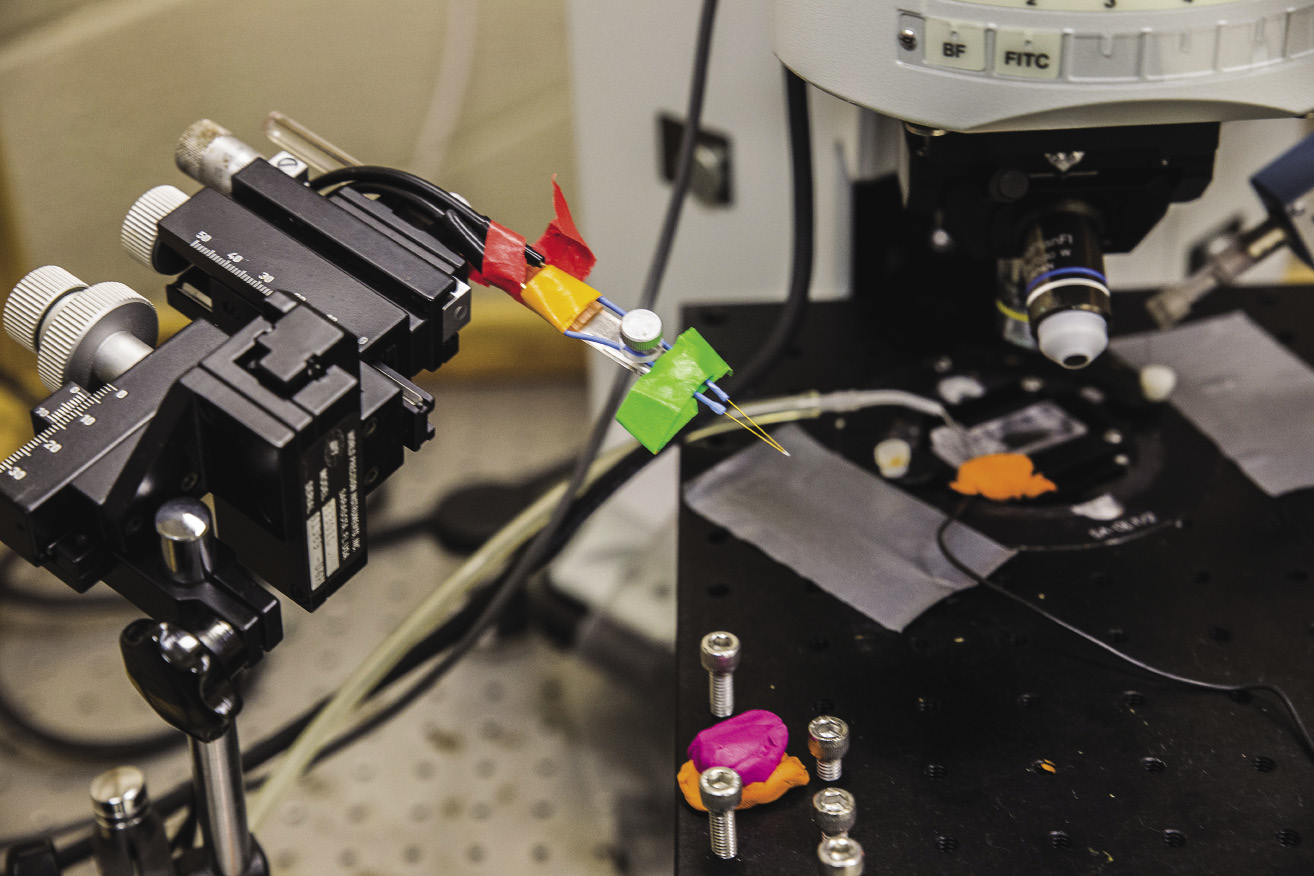On a dry winter day, you go to turn off the light and get a shock from the light switch. The next time you go to turn off that switch, you may flinch a bit. That’s what scientists call associative learning, says Elizabeth Bauer, assistant professor of biological sciences. “In this case, you learn to associate something neutral, like turning off a light switch, with something aversive, like a shock.”
In response to such stimuli, the brain starts making associations almost immediately. This all happens within the amygdala, a pair of almond-shaped lobes at the base of the brain, where experiences like these change the structure of the neural pathways. Bauer’s research looks at how we make these associations—and what happens when our fears threaten to take over. Eventually, she hopes, her research will help develop new medical approaches to help people deal with their fears.
The truth is, most people learn to be unafraid just as quickly as they can learn to get scared. Just a few times turning off the light switch without a shock, for example, and we learn to stop flinching. “It’s not that you forgot you got the shock, but you learn it’s now safe,” says Bauer. In some people, however, that fear doesn’t go away, and can even get worse due to abnormalities in the way they learn or extinguish fear responses.

Photos by Ambika Singh
People with generalized anxiety disorder, for example, extrapolate from one association to be afraid more generally. “It’s not just that you worry about one light switch—you get nervous about all light switches,” Bauer says. Those with post-traumatic stress disorder (PTSD), meanwhile, may be unable to extinguish their fears, even when they are in a situation that is now safe.
Much of Bauer’s research focuses on the interaction in the brain between fear, an emotional or physical response to a specific threat; anxiety, a more generalized worry about an unknown future threat; and stress, a physiological reaction to pressures in our environment. She works with rats, often in experiments in which she plays a tone at the same time as she delivers a shock to the animal. The rats quickly learn to associate the tone with the shock and show signs of fear, including a tendency to freeze in place. “It’s really difficult to study emotion in animals because you can’t ask them what they are feeling, especially happiness or more positive emotions,” says Bauer. “But with fear, it’s easy, because these behavioral reactions and hormonal reactions are really measurable.”
By quantifying the length of time the animals freeze, she can judge the level at which they are learning fear as a response to the negative stimuli. At the same time, she is able to attach electrodes to the animals’ brains to watch, in real time, as particular neurons in the amygdala send electric signals. “If every time a tone is played, the cell is more active, it suggests that contributes to the [fear] learning,” Bauer says. “I’ve been doing this for a long time. But it never ceases to amaze me that you can see it happen in animal after animal. It’s so cool.”
Much of the research in the lab is conducted by undergraduates, who typically work with Bauer for two to three years. “They do everything—all the behavioral observations, the surgeries, the microscope work,” she says. “It’s not like at larger universities where you have an army of postdocs and grad students and undergrads are washing glassware. Here, they are doing all of these technically difficult experiments.”
Some of her experiments investigate the role played in fear learning by a particular protein in the brain called corticotropin releasing factor (CRF). Bauer started looking at the chemical in 2011, four years after she first arrived at Barnard. Other biologists had observed that the amount of CRF is higher in the brains of people who experience chronic amounts of stress. But no one had looked at how that stress was connected to fear.
Bauer conducted experiments in which she and her students injected CRF into the brains of their rats to see how it affected their ability to learn to be afraid of the shocks. In addition, Bauer and her students used particular antibodies that bind to CRF in the brain to identify which cells were actually affected. Bauer was surprised to find that the increase in CRF didn’t seem to affect rats’ ability to learn at all; they still experienced the fear response in the same way as rats with less CRF.
Another set of Bauer’s experiments looks beyond the amygdala to another part of the brain called the bed nucleus of the stria terminalis, or BNST. It’s a collection of small and complex structures that sit above the amygdala. Unlike that brain structure, which seems focused mainly on emotion, the BNST is involved in a host of functions, including coordinating reproductive behaviors, as well as anxiety and stress.
Past experiments have shown that while the amygdala is associated with short and rapid fear responses, the BNST participates in sustained anxiety over time. The structure is also activated by a class of antidepressant drugs known as selective serotonin reuptake inhibitors (SSRIs), such as Prozac, Paxil, and Zoloft.

In her experiments, Bauer found that when rats are given SSRIs, then the BNST becomes active and does something it usually doesn’t: interact with the amygdala and participate in short-term fear learning. Bauer speculates that this change in function could help explain an occasional side effect of SSRIs, an increased risk for suicidal thoughts, especially when someone first starts taking them. “That initial increase in anxiety seems to involve the BNST,” Bauer says. By better understanding how that process works, drug developers may eventually be able to reduce this dangerous side effect.
Currently she is homing in on how fear and anxiety interact in particular types of rats. The BNST, for example, is one of the few structures in the brain that is different for male and female rats. While most of her experiments so far have been done with male rats, Bauer is starting to look at female rats to see if they process fear and anxiety differently.
Most of her experiments to date have been conducted using adult animals. But Bauer is also examining differences in fear learning among adolescent rats. For humans, adolescence is often a time of increased stress as well as increased risk for developing anxiety or depression. Bauer has already shown that adolescent rats exposed to stressful situations are less able to extinguish fears than adult rats, which could possibly explain why adolescents are more susceptible to long-term anxiety than adults.
In continuing experiments like these, Bauer hopes to get us closer to an understanding of how our fears develop in the brain, ultimately providing some possible strategies for how we might better deal with them. “That could include new drugs or behavioral therapies to affect the brain’s fear-learning processes,” helping people conquer their fears and anxieties and live more productive lives. •
Michael Blanding is a freelance writer and author of The Map Thief.
